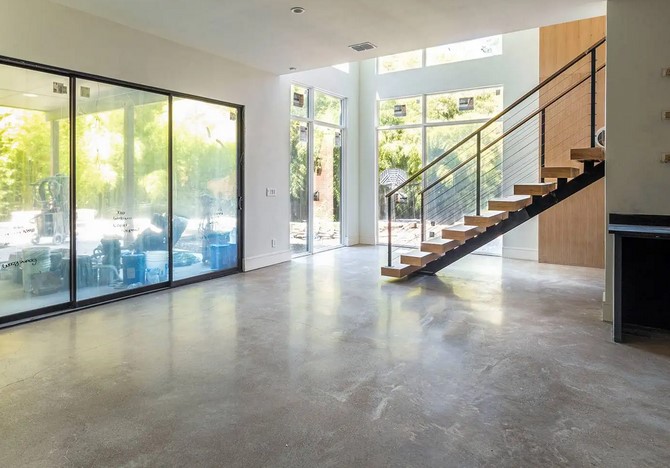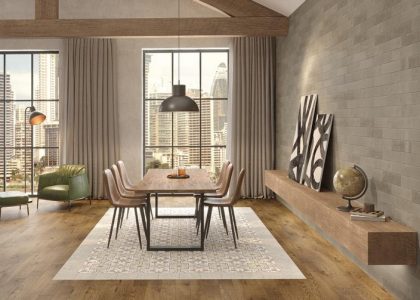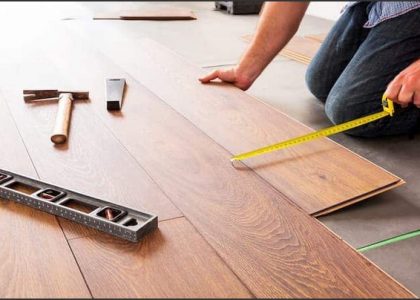
In recent years, textured concrete flooring has emerged as a popular flooring choice for both residential and commercial spaces. Combining durability, low maintenance, and aesthetic appeal, textured concrete flooring provides a versatile solution for a variety of environments. From modern homes to high-traffic commercial establishments, this type of flooring offers both functional and visual benefits. In this article, we will explore the advantages of textured concrete flooring, the various types available, and how you can incorporate this durable material into your space.
What is Textured Concrete Flooring?
Textured concrete flooring refers to a concrete surface that has been treated or altered to create a patterned, non-smooth finish. The texture can range from subtle, such as light trowel marks, to more pronounced patterns like imprinted designs or rough surfaces. This unique finish is achieved through a combination of techniques such as stamping, etching, grinding, and polishing. Textured concrete flooring is not only designed to add visual interest but also to improve functionality by offering better slip resistance and enhancing the overall durability of the floor.
The variety of finishes available for textured concrete flooring allows homeowners, designers, and architects to customize the look of their spaces while benefiting from concrete’s inherent strength. Whether you’re renovating your home or designing a commercial property, textured concrete flooring can be an ideal choice for creating a stylish and functional environment.
Benefits of Textured Concrete Flooring
Textured concrete flooring offers a host of benefits that make it a top choice for many types of spaces. Below are some of the most compelling reasons to consider this flooring option:
1. Durability and Longevity
One of the primary reasons people choose textured concrete flooring is its exceptional durability. Concrete is inherently strong and resistant to wear and tear, making it an ideal material for high-traffic areas such as entryways, kitchens, or commercial spaces. The textured surface adds to this durability, making it even more resistant to scratches, dents, and damage from heavy foot traffic, furniture, or machinery.
With proper installation and maintenance, textured concrete flooring can last for decades, making it a cost-effective investment in the long run. Unlike wood or carpet, concrete is not prone to warping, rotting, or staining, which means it can maintain its appearance and functionality for years with minimal upkeep.
2. Aesthetic Appeal
Textured concrete flooring is available in a wide range of finishes, allowing you to tailor the look to your personal style. From sleek, polished surfaces to rough, industrial finishes, you can create a variety of looks that complement the rest of your décor. Whether you want a smooth, modern aesthetic or a rustic, natural feel, textured concrete flooring can deliver the exact look you’re aiming for.
Moreover, textured concrete floors can be easily customized with color stains, dyes, or decorative patterns. For example, stamped concrete can imitate the look of stone, brick, or even wood, providing you with the charm of traditional materials without the associated maintenance costs. This flexibility in design allows you to create unique and attractive flooring that enhances the overall ambiance of your space.
3. Low Maintenance
Unlike other flooring materials such as hardwood, carpet, or tile, textured concrete flooring is remarkably easy to maintain. Regular cleaning usually involves sweeping or mopping the surface to remove dust and dirt, followed by occasional resealing to protect the surface. In high-traffic areas, you may need to reapply the sealer every few years, but the process is simple and cost-effective.
Concrete floors are also resistant to moisture, mold, and mildew, making them an excellent choice for areas such as basements, kitchens, and bathrooms. Unlike carpets, textured concrete floors do not absorb spills, reducing the risk of stains and odors. In fact, many textured concrete floors are specifically designed to be moisture-resistant, ensuring they stay in top condition even in humid environments.
4. Safety and Slip Resistance
The textured surface of concrete floors provides additional traction, making them safer and less slippery than smooth concrete surfaces. This is especially important in areas that are prone to getting wet, such as bathrooms, kitchens, or outdoor spaces like patios and pool decks. Textured concrete flooring can help reduce the likelihood of slips and falls, making it an ideal flooring choice for both residential and commercial spaces that require enhanced safety.
In addition to safety, textured concrete can help improve the overall comfort and usability of your space. The non-slip surface reduces the chances of accidents and makes the floor easier to walk on, especially when wet.
Different Types of Textured Concrete Flooring
There are several methods to create textured concrete flooring, each offering a unique finish. Here are some of the most popular techniques:
1. Stamped Concrete
Stamped concrete involves pressing molds or stamps into freshly poured concrete to create patterns or textures that mimic natural materials like stone, brick, or wood. This technique allows you to create a customized design that suits your aesthetic preferences. Stamped concrete is often used in outdoor spaces such as patios, walkways, and driveways, but it can also be applied in interior areas like living rooms and kitchens.
2. Polished Concrete
Polished concrete flooring is achieved by grinding and polishing the concrete surface to a smooth, glossy finish. While polished concrete is typically smooth, it can also be textured to provide a non-slip surface while maintaining a sleek, modern appearance. Polished concrete is commonly used in both residential and commercial environments and is highly regarded for its durability and sophisticated look.
3. Exposed Aggregate Concrete
Exposed aggregate concrete involves removing the top layer of the concrete mix to reveal the natural aggregates, such as pebbles, stones, or sand, embedded in the surface. This creates a textured and visually interesting surface that is both attractive and durable. Exposed aggregate is often used in outdoor settings, including driveways and patios, but can also be used in indoor spaces for a more rustic or natural feel.
4. Troweled Concrete Finishes
A troweled finish is achieved by smoothing the concrete surface using a hand or power trowel. Depending on the technique used, this finish can vary from very smooth to slightly textured. This type of finish is popular for creating floors with a subtle texture that still maintains a sleek appearance. Troweled finishes are commonly used in both residential and commercial applications.
How to Care for Textured Concrete Flooring
Maintaining textured concrete flooring is relatively simple but requires periodic care to preserve its appearance and functionality. Here are some basic maintenance tips:
- Clean Regularly: Sweep or vacuum your floor regularly to remove dirt, debris, and dust. Mop the floor with a mild cleaning solution to keep it fresh and clean.
- Reseal Periodically: Depending on the amount of foot traffic and use, reseal your concrete floor every few years to protect it from stains, moisture, and wear.
- Avoid Harsh Chemicals: Use cleaning solutions that are specifically designed for concrete to avoid damaging the surface. Avoid harsh chemicals that can break down the sealer or etch the concrete.
- Repair Cracks Promptly: While concrete is durable, it can still crack over time. If you notice any cracks, address them immediately by patching the area with concrete filler to prevent further damage.
Textured concrete flooring is an excellent choice for homeowners and businesses looking for a durable, stylish, and low-maintenance flooring solution. Its versatility, customizability, and ability to withstand wear and tear make it suitable for a wide range of applications, from residential living spaces to high-traffic commercial areas. With the proper care, textured concrete flooring can enhance the beauty and functionality of your space for years to come. Whether you’re aiming for a rustic look, a sleek modern finish, or a pattern that mimics natural materials, textured concrete flooring offers endless possibilities for design and long-lasting performance.



